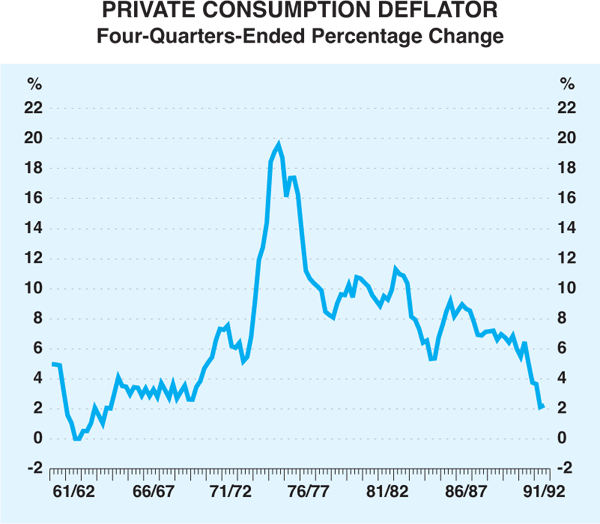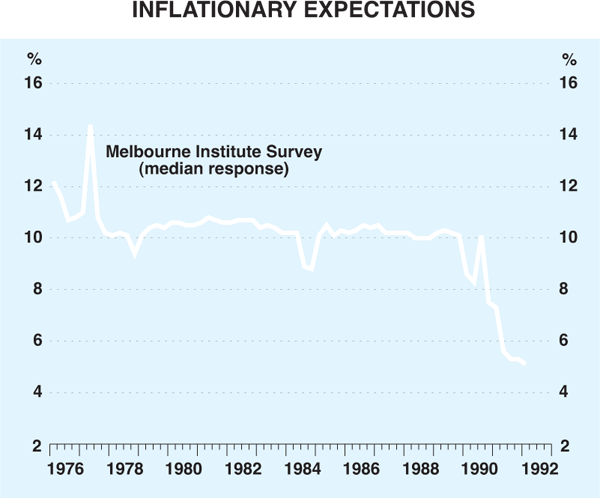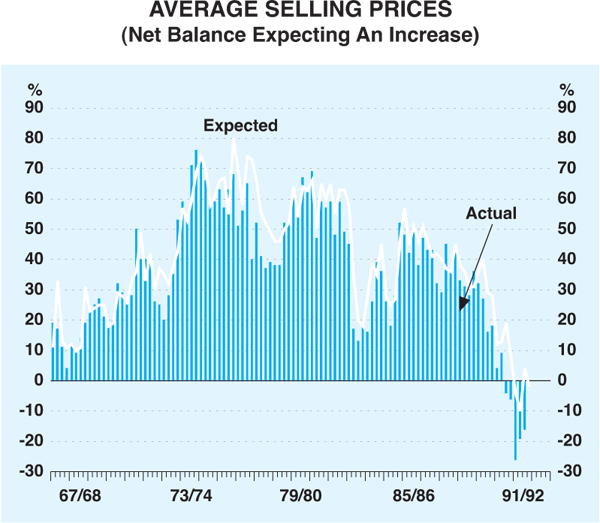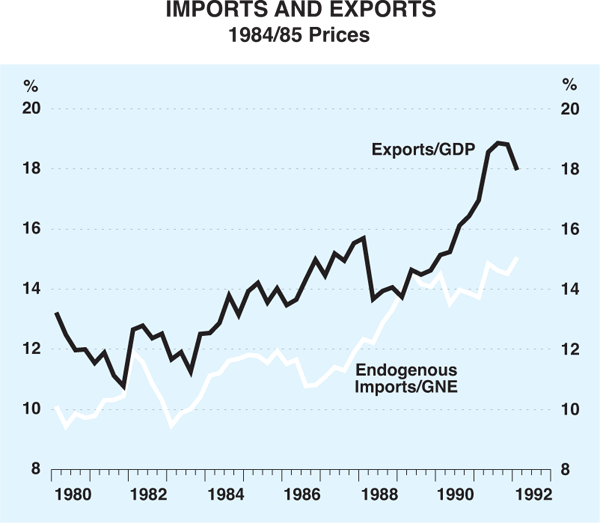Speech The Structural Adjustment to Low Inflation
Two years ago the CPI was growing at 7.7 per cent, and interest rates were in the mid to high teens. This did not seem unusual by Australian standards. Indeed, the average forty year old Australian would have had experienced little else in their working lives. In the 1970s, inflation had averaged a bit above 10 per cent, and in the 1980s a bit below. Interest rates, by the time they had completed the adjustment to reflect the higher rate of inflation were stuck in the teens. Australia was viewed internationally as a country which had resigned itself to a high inflation-high interest rate environment. It is not as though we hadn't tried to wind back inflation, but when we had, the results had been disappointingly slow.
The change since two years ago is really quite remarkable and has caught most people by surprise. Are we to conclude from the sharpness of the fall that it is temporary, or should we conclude that we have finally shaken off two decades of relatively high inflation? Obviously, we cannot say either with certainty, but it has been our view for some time that we have made a structural downward shift in inflation and that, with reasonable policies, we should be able to retain it.
Why Inflation Should Remain Low
The main reasons that have made us think that the fall in inflation is more structural than cyclical are as follows:
- We tend to think of the last two decades as being a period of continuously high inflation, and I suspect that what we think is what matters because it determines our inflationary expectations. However, this picture is a bit of a caricature. If you look at a broad indicator of inflation – like the consumption deflator – you see that after an initial very high peak in 1974, there has been a downward trend. I call it a trend because each peak has been lower than its predecessor and so has each trough. Note also that the last peak was as far back as December 1986. This means that we were making some progress during the last few years of the eighties, although it did not seem so at the time.
-
Even though inflation fell in the recessions of the mid seventies and the early eighties, it never got back to sixties' levels. This one is different because we have had newspaper banner headlines this time saying things like ‘inflation at a 28-year low’.
Graph 1
-
There has been a fall in inflationary expectations this time which we have never had before. The most common measure of inflationary expectations is the survey conducted by the Melbourne Institute. This indicated that for most of the late seventies and eighties inflationary expectations stayed at double-digit levels. Graph 2 shows this, but it is slightly different to the usual depiction of these expectations in that it shows the median response rather than the mean. It shows that for nearly fifteen years the median expectation was about 10 per cent or a little higher. I suppose this is a good measure of inflation proneness that quarter after quarter people expected inflation to be at 10 per cent, even after it had been in single digits for five years. It is only since the beginning of 1990 that inflationary expectations have come down. They started to edge down at first, but after we got the first clear picture that inflation had fallen in September 1990, they fell more sharply.
Graph 2
There is another series on inflationary expectations which has been going even longer than the Melbourne Institute series and that is the one conducted by the Confederation of Australian Industry and Westpac. They ask firms in the manufacturing industry whether they expect to raise their own selling prices in the coming quarter.
As you can see, quarter after quarter for twenty years the majority of respondents assumed that they would raise their selling prices (and they did). It is only over the last 18 months that this automatic assumption has been broken, and a majority expect that they won't be able to increase their selling prices. This is a very big break with tradition, and a major piece of evidence that something more than cyclical has happened.
- The other big change is the behaviour of wages. In its early years the Accord helped restore factor shares back to their 1960s' position. This proved to be very helpful for employment and investment. However, the fall in real wages that was a necessary part of this adjustment, looked likely to introduce a new rigidity into the system. The rigidity, it was argued, would occur because organised labour would not permit any further falls in real wages, and therefore they would demand and receive a centralised wage increase equal to the inherited rate of inflation. This would put a ‘floor’ of about 7 per cent under the inflation rate. At the time this view seemed reasonably plausible, and it made a number of people despair that we would ever be able to reduce the core rate of inflation.

Recent events have, however, confounded this pessimistic interpretation.
- First, the rate of growth of earnings has come down pari passu with the rate of inflation. In the event, there turned out to be no ‘floor’; what was left of the centralised system was flexible enough to adjust to the recession and the sharp fall in consumer prices.
- Second, for the first time that I am aware, the union movement has accepted the principle that Australian wages should be determined in relation to the growth in prices and wages of our trading partners. This is a very big change of attitude, and it mirrors some other changes that are going on in the economy at the same time.
- It is a truism to say that we are becoming increasingly integrated into the world economy. The usual explanations would point to reductions in tariffs and quotas, the increased mobility of international capital, the ending of exchange controls. As well as these regulatory changes, there has been a change in attitude making us more outward looking in general, and more conscious of our role in Asia. The outward looking attitude imposes a discipline on us which helps to keep movements in our cost and price structure at least in line with the rest of the world, or preferably better. The increasing orientation towards Asia provides us with an enormous opportunity, which we have already responded to, and will no doubt do a lot more. Much more could be said about this subject but I will content myself with showing Graph 4 below. It shows the increasing outward orientation of the Australian economy.

Import and export volumes have both grown much faster than GDP over the last decade; the former has received a lot of attention, the latter much less than it deserves.
I have given my reasons for believing that we are entering a new low inflation era, or should I say returning to our historically normal position of low inflation. Not everyone agrees with this relatively optimistic assessment. First, there are those who think that the fall in inflation is temporary, and second, there are those who think that it was achieved in too costly a manner. The rest of my talk will deal with these two views in turn.
Bond Market Views of Inflation
People who doubt that the fall in inflation is sustainable are sceptical of the evidence from price expectations.
They point out that longer-term price expectations have not fallen as much as the short-term expectations shown in Graphs 2 and 3. Their evidence for this is usually the bond market, which is the only systematic indicator of longer-term price expectations. A rising yield curve, such as we have at present, is taken as evidence that the bond market expects inflation to rise in a year or so. Is this evidence from the bond market inconsistent with the view that inflation has fallen structurally? I think not, for several reasons:
- In a technical sense, the bond market could reasonably expect some rise in inflation from the present rate as ‘special downward factors’ such as the fall in mortgage interest rates drop out of the numbers. We would not quibble with this; we have pointed out that, although the headline inflation rate is now 1.7 per cent, this is partly an aberration and the underlying rate is probably 2½ to 3 per cent.
- In a more fundamental sense, the bond market, in looking ten years ahead, is, of necessity, making an economic forecast. All economic forecasts are difficult and imprecise and forecasters tend to be conservative and sceptical of change. All forecasters, and I include my own institution in that group, failed to predict the size of the recent fall in inflation. We all lag behind actual events, and it is foolish to expect the bond market to have powers above and beyond mere mortals. Having said that, they have not done too badly compared to earlier episodes. If you look at the US experience with a sharp deflation – the Volcker deflation of the early eighties – you see a very slow adjustment in the bond market. By 1981 inflation in the US had been in double digits for three successive years. The ten-year bond yield had risen to 13.9 per cent. In 1982 inflation dropped to 6.2 per cent, but the bond yield only moved down to 13.0 per cent. In 1983 inflation dropped to 3.2 per cent while the bond yield was 11.1 per cent. Thus a very sharp, and ultimately sustained, fall in inflation in the US produced relatively small falls in bond yields in the first two or three years. Compared with this example, the Australian bond market has adjusted reasonably quickly.
- The yield on a conventional Commonwealth ten-year bond is a little above 9 per cent, while the yield on an indexed bond is a bit over 5 per cent. This means the market has factored in 3½ to 4 per cent per annum for inflation over the next ten years. To me, this represents a reasonable adjustment of expectations, given all the uncertainties and risks associated with forecasting. On a more specific level, I recently listened to a sales presentation by a quite sophisticated Australian financial institution in the bond market. They showed a number of graphs and calculations of future rates of return. The inflation assumption that underlay these calculations was 4 per cent per annum over the next ten years. While this is higher than current inflation, and higher than I expect inflation to be, it would have been unthinkable to have used a number as low as this even two years ago.
While there is still probably some further adjustments to be made, the evidence is that long-term inflation expectations are coming down substantially and this will increase the probability that low inflation can be maintained.
The Cost of Reducing Inflation
The other argument that I referred to earlier was that we have paid too high a cost to reduce the rate of inflation. This is a very difficult charge to answer because no one likes recessions, and the rise in unemployment and business failures, that goes with them. It would be nice if we had been able to reduce inflation substantially without having had to pay any cost in terms of lost output and employment. However, this is rather a Utopian wish for several reasons.
It was clear by the late eighties that policy, including monetary policy, had to be tightened to bring a substantial slowing in the economy. The economy was growing too fast, we were living beyond our means and there was an unsustainable amount of debt financed asset speculation occurring. The dynamics of a modern capitalist economy are such that it is hard to believe that this excess could be followed by a gentle slowing; it was far more likely that it would be followed by an absolute contraction.
Some people think that if only the instruments of monetary policy had been adjusted in a more skilful and timely manner, we might have avoided a recession, but I very much doubt it. The business cycle is a fact of life; it can be ameliorated but not fine tuned away. Unfortunately, 1991 has to be added to a list of post-war recessions that include those of 1951, 1961, 1974 and 1982. We are not the only country to have had this experience. Over the last couple of years, most of the OECD countries have experienced a recession as conventionally defined and in half a dozen it has been deeper than ours.
Even so, there is a strong feeling in many quarters that more should have been done to avert the recession. Perhaps it would have been possible to have a somewhat smaller recession, if all the policy guns had been quickly trained towards maximum expansionary impact. But if we had followed this course, how could people credibly have believed we were serious about reducing inflation? We claimed at the time that 1990/91 was a once-in-a-decade opportunity to return to low inflation; everyone would have concluded that we were not serious about taking the opportunity. We could not have expected the community to reduce their wage and price claims, if all our actions indicated a pre-occupation with minimising the recession at any cost.
There are no absolutes in this. I have already explained why monetary policy should not have been directed single-mindedly to smoothing the cycle. To do so would throw away the opportunity to reduce inflation. Similarly, if it had been single-mindedly directed to maximising the fall in inflation, the high interest rates of 1989 would have been maintained longer, and the recession would have been deeper. It could well have led to a larger fall in inflation, but in our view the cost would have been too high.
Of course, when it comes to practice, all this is very imprecise. No one can exactly calculate the required measure of monetary easing, nor are forecasts a reliable guide. In this episode all forecasters – private and public – underestimated the size of the recession and size of the fall in inflation. Every policy action involves making guesses and accepting the risk that it may prove to be too much or too little. The central point is, that on this occasion we had to run monetary policy somewhat tighter than in earlier recessions, and take the risk that the fall in output would be greater than forecast. To do less than this would be to throw away the once-in-a-decade opportunity for Australia to regain an internationally respectable inflation rate. The question is – did we pay an unacceptably high price?
I know of no country in the post-war period that has achieved a significant reduction in its core rate of inflation without a contraction in output. Even the ones that are regarded as most virtuous in terms of inflation performance such as Germany, Switzerland and Japan, have had to pay a heavy price to bring inflation back under control when it got away from them in the mid seventies and early eighties. We are no different other than we have done the adjustment in the early nineties.
While I doubt that it is possible to achieve a major reduction in inflation without a contraction in output, it is possible to have a recession that has little or no favourable impact on inflation. A number of countries which have experienced recessions over the last year or two have got little or nothing to show for it in terms of lower inflation. For example, US inflation is now about the same as it was in the five years before they entered the recession, in the UK it is higher.
It is true that we paid a substantial price to reduce inflation, but we had to do it at some stage. Maintaining high inflation because of the unwillingness to pay the costs of reducing it, is not a viable option. We have paid the cost, the task now is to maintain low inflation when we return to growth.
